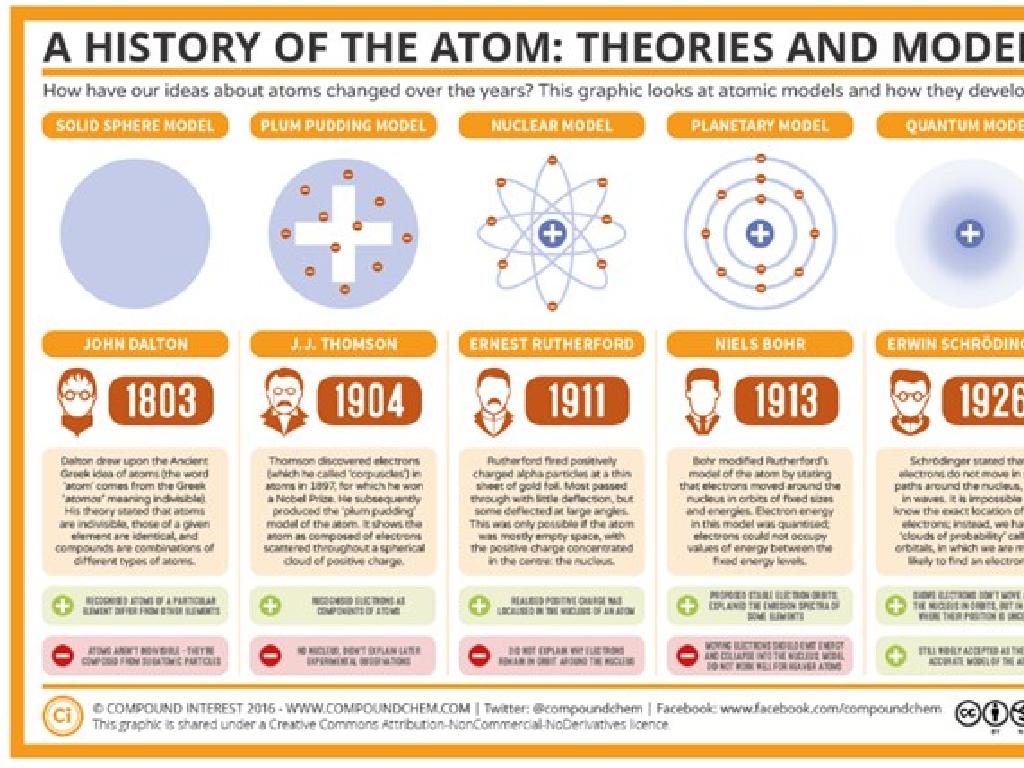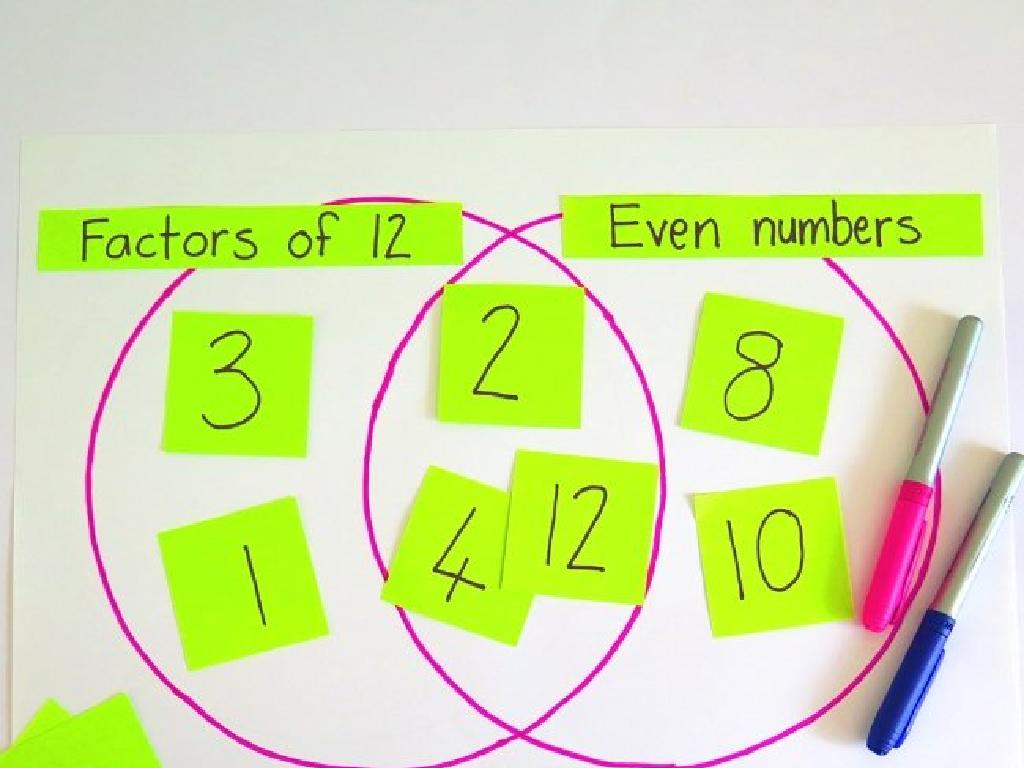Animal Cell Diagrams: Label Parts
Subject: Science
Grade: Sixth grade
Topic: Cells
Please LOG IN to download the presentation. Access is available to registered users only.
View More Content
Exploring Animal Cells: The Building Blocks of Life
– Cells: Life’s foundational units
– Animal vs. Plant Cells
– Animal cells lack a cell wall and chloroplasts, unlike plant cells.
– Components of Animal Cells
– Nucleus, mitochondria, and more to explore.
– Today’s focus: Labeling Animal Cells
– We’ll identify and label key parts of an animal cell.
|
This slide introduces the concept of cells as the basic structural units of all living organisms. Highlight the differences between animal and plant cells, such as the absence of a cell wall and chloroplasts in animal cells. Provide a brief overview of the various components that make up an animal cell, including the nucleus, mitochondria, and other organelles. The main activity for today’s class will be to label the parts of an animal cell diagram, which will help students visually understand the structure and function of each component. Encourage students to ask questions and express any curiosity they have about cellular biology.
Exploring Animal Cells
– Define animal cells
– Basic unit of life, lacks cell wall unlike plant cells
– Compare with plant cells
– Animal cells don’t have chloroplasts, unlike plant cells
– Animal cells in the body
– Perform various functions like energy production, reproduction
– Unique characteristics
|
This slide introduces the concept of animal cells, highlighting their definition and characteristics. It’s important to emphasize that unlike plant cells, animal cells do not have a cell wall or chloroplasts, which are essential for photosynthesis. Discuss the various roles that animal cells play in the body, such as energy production, reproduction, and response to stimuli. Use diagrams to illustrate the differences between animal and plant cells. Encourage students to think about the importance of each cell part and how they work together to keep the animal healthy and functioning.
Exploring the Animal Cell
– Identify animal cell parts
– Learn to label cell parts like a biologist
– Functions of membrane, cytoplasm, nucleus
– Membrane: cell’s barrier, Cytoplasm: cell’s fluid, Nucleus: control center
– Organelles: mitochondria, ribosomes
– Mitochondria: power generators, Ribosomes: protein builders
– Understanding organelle roles
– Each organelle has a unique and vital function
|
This slide introduces students to the basic structure and functions of an animal cell. Start by identifying each part of the cell and its location. Explain the roles of the cell membrane as a protective barrier, the cytoplasm as the site of chemical processes, and the nucleus as the control center of the cell. Introduce organelles such as mitochondria and ribosomes, explaining their functions as the cell’s powerhouses and protein synthesis sites, respectively. Use diagrams to help students visualize and understand the roles of each organelle. Encourage students to ask questions and think about how each part contributes to the cell’s survival and function.
Deep Dive: Organelles in Animal Cells
– Explore endoplasmic reticulum
– A network that helps in protein and lipid synthesis
– Powerhouse: the mitochondria
– Mitochondria generate the cell’s energy
– Vacuoles & vesicles function
– They store materials and transport substances
– Golgi apparatus & lysosomes
– Involved in modifying, packaging, and transporting proteins
|
This slide takes a closer look at the complex inner workings of animal cells, focusing on the specific roles and functions of organelles. The endoplasmic reticulum is a network-like structure that plays a critical role in the synthesis of proteins and lipids. The mitochondria are known as the cell’s powerhouse because they convert nutrients into energy that the cell can use. Vacuoles and vesicles are essential for the storage and transport of materials within the cell, ensuring that substances are moved to where they are needed. The Golgi apparatus and lysosomes work together to modify, package, and transport proteins, which are crucial processes for cell maintenance and function. Encourage students to think of these organelles as parts of a factory, each with a specific job that helps the cell operate efficiently. Provide diagrams for visual aid and consider using analogies to help students relate the functions of these organelles to real-world systems they are familiar with.
The Nucleus: Command Center of the Cell
– Explore the cell’s nucleus
– The nucleus directs cell activities and contains genetic material.
– DNA: Blueprint for life
– DNA holds instructions for traits and making proteins.
– Nuclear membrane functions
– The nuclear membrane protects DNA by controlling entry and exit.
– Nucleolus: The nucleus within
– The nucleolus makes ribosomes for protein synthesis.
|
This slide introduces the nucleus as the control center of the cell, highlighting its critical roles in heredity and protein synthesis. Emphasize the nucleus’s function in storing DNA, which contains the instructions for all cellular processes and hereditary information. Discuss the nuclear membrane’s selective permeability, which is crucial for maintaining a stable environment for DNA. The nucleolus’s role in ribosome production should also be explained, as ribosomes are essential for protein synthesis. Encourage students to think of the nucleus as the cell’s ‘brain,’ orchestrating the complex activities that sustain life. Provide diagrams for visual aid and consider using analogies to help students grasp these concepts.
Interactive Labeling: Animal Cell Organelles
– Label animal cell organelles
– Identify each organelle’s role
– Nucleus as the control center, mitochondria as powerhouses
– Discuss organelle functions
– Why is the nucleus important? How do mitochondria power the cell?
– Engage in interactive activity
|
This slide introduces an interactive labeling activity where students will identify and label the main organelles of an animal cell. Provide a diagram of an animal cell without labels and ask students to place the correct label on each part. After labeling, facilitate a discussion on the function of each organelle, emphasizing the nucleus’s role in controlling cell activities and the mitochondria’s function in energy production. This activity will help students visually connect each part of the cell to its function, reinforcing their understanding of cell biology. Possible variations of the activity could include group work, timed challenges, or using digital tools for labeling.
Class Activity: Create Your Own Cell
– Craft a 3D animal cell model
– Present and explain organelles
– Describe the role of structures like the nucleus, mitochondria, etc.
– Hands-on reinforcement
– Enhances retention
|
In this engaging class activity, students will use various craft materials to construct a 3D model of an animal cell. This creative task allows students to explore the cell’s structure in a tangible way. Each student will then present their model to the class, explaining the function of each organelle, such as the nucleus, mitochondria, and endoplasmic reticulum. This activity not only reinforces the lesson content but also aids in long-term retention by involving multiple senses in the learning process. For the teacher: Prepare a list of materials needed for the models, ensure each student can access these materials, and consider pairing students for collaborative learning. Provide a rubric for the presentation to guide students on what to include in their explanation.
Review and Q&A: Animal Cell Diagrams
– Recap today’s key points
– We covered cell parts like the nucleus, mitochondria, etc.
– Ask your questions now
– Clarify any confusion
– Let’s clear up any tricky parts
– What’s next: Plant Cells
– Get ready to explore how plant cells differ
|
This slide is meant to summarize the lesson on animal cell diagrams and ensure students have a clear understanding of the material. Start by recapping the main components of an animal cell, such as the nucleus, cytoplasm, mitochondria, and more. Encourage students to ask questions or express parts of the lesson they found challenging. Use this opportunity to address any misconceptions or provide additional explanations. Finally, generate interest for the next lesson by briefly mentioning that students will learn about plant cells, hinting at the differences they will discover compared to animal cells. This will help them transition smoothly into the next topic.






